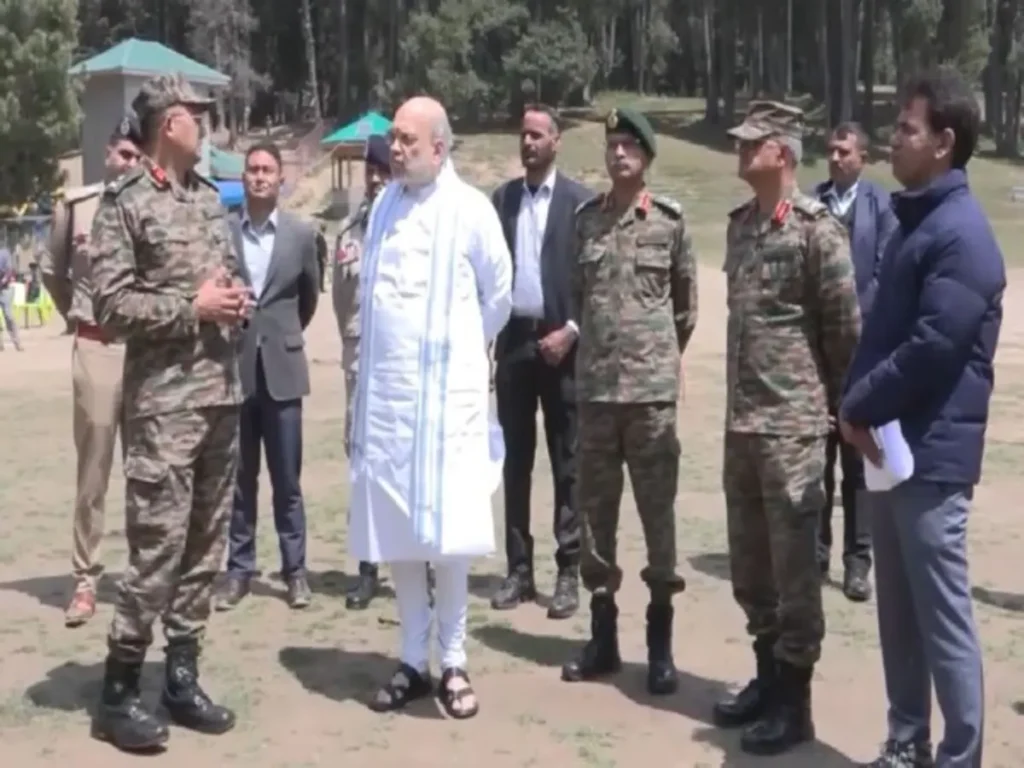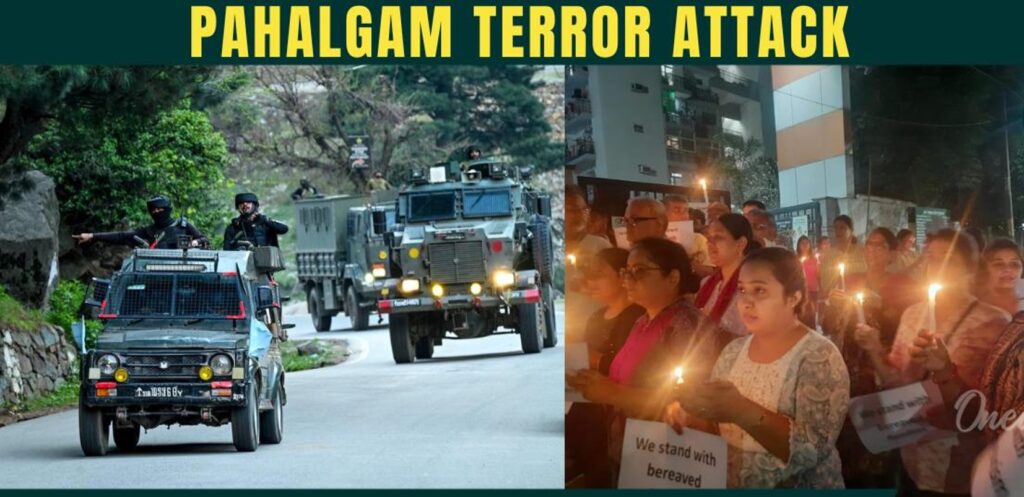Overview of the Attack
On April 22, 2025, the tranquil Baisaran meadow near Pahalgam, a scenic tourist destination in Indian-administered Kashmir, became the site of one of the deadliest terrorist attacks in the region in two decades. Four armed assailants targeted civilians, killing 26 people, including 25 tourists and a local pony operator. Witnesses reported that the attackers singled out Hindu men, demanding they recite Islamic verses before executing those who could not comply. The attack occurred just days before Prime Minister Narendra Modi’s planned visit to inaugurate a railway project, which was later canceled due to weather concerns.
#PahalgamAttack, #KashmirTerrorAttack, #IndiaPakistanTension, #JammuKashmirViolence, #TRFTerrorism, #NarendraModiOnTerrorism, #KashmirTouristAttack
Perpetrators and Tactics
The attackers employed a chilling strategy: two terrorists disguised themselves among tourists, while two others lay in wait with automatic rifles. As panic erupted after the initial gunfire, the infiltrators herded the crowd toward the armed assailants, preventing escape and enabling the massacre. The Resistance Front (TRF), a group linked to Pakistan-based Lashkar-e-Taiba (LeT), initially claimed responsibility via Telegram but later retracted the statement, alleging a cyber intrusion by Indian intelligence. Indian authorities identified three suspects—two Pakistani nationals and a local Kashmiri guide—though the fourth remains unidentified.

Weapons Used: The terrorists wielded automatic rifles, which were used to execute victims at point-blank range. The choice of firearms and the premeditated herding tactic underscored the attack’s strategic brutality.
Victims and Aftermath
The victims included tourists from across India, many of whom were visiting Kashmir during the pre-summer season. Survivors described scenes of horror, with militants segregating individuals based on religion before opening fire. The attack ignited nationwide outrage, prompting vigils, protests, and calls for justice.

Families of the deceased, such as the widow of Lt. Vinay Narwal (a naval officer killed in the attack), appealed for peace and urged against retaliatory violence toward Kashmiris.
Government Response and Retaliatory Measures
The Indian government adopted a multi-pronged approach to address the crisis:
- Security Crackdowns: Over 3,000 individuals were detained in Kashmir, with 90 booked under the Public Safety Act (PSA). Security forces demolished homes linked to suspected militants, a move criticized as “collective punishment” by former Chief Minister Mehbooba Mufti.
- Diplomatic and Economic Actions: India suspended the Indus Waters Treaty, expelled Pakistani nationals, and closed airspace to Pakistani aircraft. Pakistan retaliated with visa suspensions and the annulment of a 1972 peace treaty.
- Military Preparations: The Indian Air Force conducted drills along the Pakistan border, deploying advanced Rafale jets and BrahMos missiles. Meanwhile, Pakistan bolstered its defenses with Chinese J-10 fighters and Turkish drones.
- Domestic Measures: The Home Ministry ordered nationwide mock drills on May 7 to prepare civilians for potential attacks, involving 300 districts with critical infrastructure.

Pursuit of Justice
India vowed to “identify, track, and punish” the perpetrators “beyond their imagination”. However, the crackdown faced backlash for targeting innocent Kashmiris. For instance, a 23-year-old laborer in Kulgam died during a security operation, with his family denying militant ties.

Political leaders like J&K Chief Minister Omar Abdullah cautioned against alienating civilians, emphasizing that the crackdown should focus on culprits, not communities. Internationally, the U.S. urged de-escalation, while the UN condemned the attack and called for dialogue.
Will the Cycle of Violence Continue?
The attack has deepened the India-Pakistan stalemate, with historical precedents suggesting a high risk of escalation. Past responses to attacks in Uri (2016) and Pulwama (2019) involved cross-border strikes, but the Pahalgam assault’s civilian toll raises the stakes. Experts warn that upgraded military capabilities on both sides—such as India’s Rafale jets and Pakistan’s J-10 fighters—could lead to a more dangerous confrontation.

Factors Influencing Future Stability:
- Domestic Pressure: Public anger in India may push the government toward military retaliation, despite risks of nuclear escalation.
- Kashmiri Alienation: Heavy-handed security measures risk fueling resentment in Kashmir, undermining counterterrorism efforts.
- International Mediation: The U.S. and UN have urged restraint, but their influence remains limited. Australia’s proposal to assist with Indian Ocean surveillance highlights potential for indirect support.
Conclusion: A Fragile Path Forward
The Pahalgam attack underscores the volatile intersection of terrorism, geopolitics, and communal tensions in South Asia. While India’s government seeks to project strength through military and diplomatic measures, the human cost of retaliatory actions—both in Kashmir and beyond—poses significant ethical and strategic challenges.

Justice for the victims must balance accountability with restraint to avoid perpetuating cycles of violence. The international community’s role in facilitating dialogue and intelligence-sharing could prove pivotal, but lasting peace will require addressing the root causes of radicalization and fostering trust between Delhi and Kashmiris. As historian Ajay Bisaria noted, the crisis reveals both an “escalation instinct and a de-escalation instinct” in India-Pakistan relations—a duality that will shape the region’s trajectory in the coming months.
#LashkarETaiba, #IndusWatersTreaty, #RafaleVsJ10, #JusticeForPahalgamVictims, #StopKashmirViolence, #IndiaAgainstTerrorism, #PrayForKashmir, #EndPakistanTerror, #IndiaDefenseNews, #PakistanTerrorLinks
For more news like this please visit : https://india.latestbroadcasters.com/
-
War 2: Hrithik vs NTR – A Spy Universe Storm Unleashed

War 2, releasing August 14, 2025, stars Hrithik Roshan as rogue agent Kabir and Jr NTR as a layered antagonist in a globe-trotting spy thriller. Directed by Ayan Mukerji, it features high-octane action across six countries, expanding YRF’s Spy Universe. Release Date and Global Anticipation Scheduled for a theatrical release on August 14, 2025, War 2 aims to capitalize on India’s Independence Day weekend,…
-
Tamil Stars Vishal and Sai Dhanshika Announce Wedding: A Journey from Friendship to Forever

Celebrated Tamil actors Vishal Krishna, 47, and Sai Dhanshika, 35, have officially declared their union, ending years of speculation about their personal lives. The couple revealed their wedding date as August 29, 2025, during a press event for Dhanshika’s upcoming film Yogi Da in Chennai. Notably, the date coincides with Vishal’s birthday, adding a dual celebration to their…
For more Follow : india.latestbroadcasters.com
You can follow our another channel : latestbroadcasters.com


